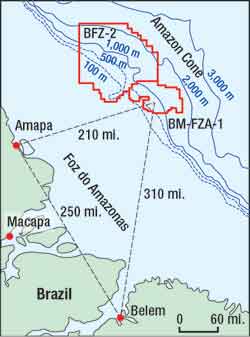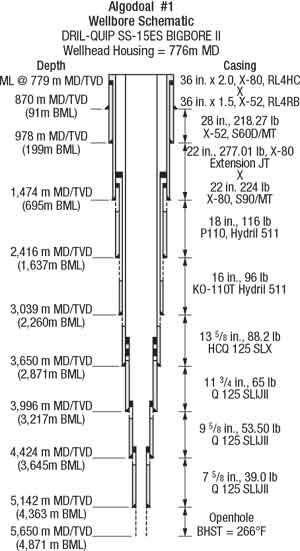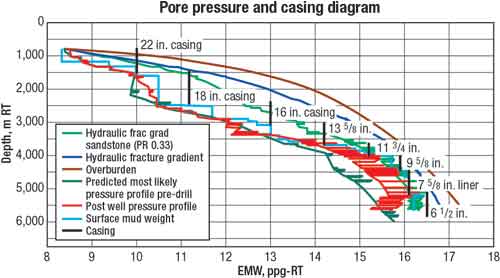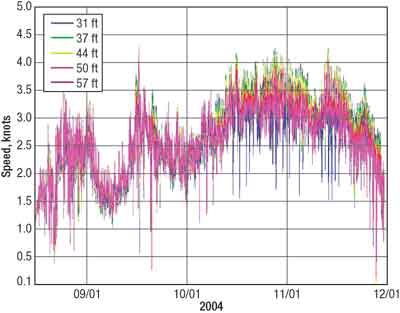|
Vol. 227 No. 11 |
| |
 |
Drilling a deepwater wildcat offshore Brazil
Planning, logistics and a diverse team produced an efficient operation.
Dan M. Sparkes, James S. Wellings and Gregory T. Rheaume, BP
Project delivery according to plan and with minimal cost depends on having the right people, processes, and technology in place. The consequences of not adequately implementing these for difficult drilling projects can result in failure to reach objectives and/or substantial overspending. This article outlines the processes used to get the appropriate people and technology in place to deliver a high-pressure, high-temperature, deepwater wildcat off the northern coast of Brazil.
WELL CONTROL
Algodoal 1 was a 5,650-m wildcat well drilled in late 2004, in 776 m of water about 200 mi off Brazil's northern coast, Fig. 1. The project set records as the deepest well drilled off Brazil's northern coast and the highest pore pressure well ever drilled in Brazil.
 |
Fig. 1. The Algodoal 1 well was drilled in late 2004 in 776 m of water about 200 mi off Brazil's northern coast.
|
|
The well was planned with nine strings of casing using seismic-derived pore and fracture pressure gradients for shale and derived fracture gradients for permeable intervals (i.e. sand fracture gradient), Fig. 2. The casing design was based on the most likely shale pore and fracture pressure profiles. Risk assessment and peer review were conducted to determine contingencies for higher-than-expected pore pressure and to determine how lower sand fracture pressures would compromise reaching planned TD. Contingencies for extra casing strings were included in the well design to cover a high-side pore pressure/ low fracture pressure well.
 |
Fig. 2. The well was planned with nine casing strings, telescoping from 36 in. at the surface to 8½ in. at the last casing point.
|
|
The well's pore and fracture pressure profile showed that pore pressure was higher than the seismic-derived prediction. Sand fracture pressures were on the low side, which resulted in the use of all nine casing strings and some innovative drilling techniques to reach TD, Fig. 3.
 |
Fig. 3. The nine casing points were chosen using seismic-derived pore and fracture pressure gradients for shale, and derived fracture gradients for permeable intervals.
|
|
During drilling operations, permeable intervals reduced the pore/ fracture pressure window, leading to severe wellbore ballooning (loss of drilling mud with pumps on and gain of lost mud with pumps off), due to additional BHP caused by the Equivalent Circulating Density (ECD). As in most deepwater operations, the tight pore/ fracture pressure window must be managed to ensure each casing string is set as deeply as possible to reach the target TD with the available strings. For this well, it was accomplished using several tools to ensure optimal casing setting depth. The risks of losing the well versus not reaching objective were weighed continuously and managed to ensure there was no harm to personnel or environment.
TOOLS
Several tools proved advantageous in differentiating between a formation kick and ballooning.
- Dual LWD passes. While tripping out of the hole, slow passes were made over suspected loss zones to capture and compare a "repeat pass" LWD resistivity log with the original. The helped delineated drilling mud invasion and confirm where ballooning occurred.
- Mud logging software. Data capture and analysis software allowed not only connection fingerprinting, laying data from multiple connection flow-backs over top one another, but also over top data from other wells. A detailed accounting of fluid lost and recovered, properly adjusted for product additions, cuttings, pipe displacement, etc. could also be maintained over short-term events and the entire hole section.
- Downhole Pressure While Drilling (PWD). This enabled finer control over ECD effects and aided in ballooning post analysis. PWD could also show when ballooning flow-back mud was of low density and should be circulated through the choke, rather than the riser.
- Continuous measurement. The return mud density, oil/ water ratio, gas, and chlorides data were fed into the software and reviewed with other data to determine likely situations for downhole loss and flow.
- Flow control. Return flow intensity and controlled flow back to the trip tank were used together while fingerprinting connections, due to their ability to detect flow early.
PEOPLE
A wellsite and office team with experience in deepwater and exploration drilling was a key to well delivery. On the rig site, 28 nationalities were represented. Personnel that monitored and controlled the well represented experience from most of the world's deepwater basins. The operator's rig site and office staff, drilling contractor, mud service company and mud-logging company were involved in operational decisions. Under the guidance and authority of a single leader with project accountability, decisions were made by consensus.
Diverse experience was important during ballooning. At section TD in the deepest sections, the well was flowed repeatedly, fully circulated and flowed again to achieve stability for tripping. The influx was lost mud in all cases. To ensure that a gas kick was not circulated into the riser above the subsea BOPs, flow-back and BHP data were overlain on connection flow-back data and data on other wells. The well-site leader, engineer and pore pressure specialist made consensus decisions to stop or continue to flow mud back into the well. While experience on similar projects might have led to faster decisions, the challenge and alternate perspectives within the group made for solid decision-making. The wellsite leader's experience with formation ballooning was essential, as the procedures followed were unconventional or unacceptable in most other situations.
The offsite team included the operator's pore pressure prediction and rock mechanics technology experts. This ensured the highest prediction quality and enabled the application of emerging techniques, such as induced wellbore strengthening through stress cages.1, 2
Pore pressure predictions were made independently by the operator's and the mud-logging company's pore pressure specialists using different software. The predictions were compared twice daily, when drilling ahead without kick tolerance.
Using such an extensive decision-making team required effective communication between the rig site and onshore sites in multiple countries. Satellite connections allowed for internet protocol meetings and conference calls.
TECHNOLOGY TRANSFER
The most important technology transfers that occurred within BP were the use of: the "Big Bore" wellhead system, real-time pore pressure monitoring and prediction, a Linear Alpha Olefin (LAO) Synthetic Oil Based Mud (SOBM) system to facilitate head space gas analysis, a fifth-generation drillship for remote logistics and sea current management, and operational experience.
Service providers were selected, based on their ability to provide and support the appropriate technologies in Brazil. People played a critical role in technology transfer, and the awarding of a contract or service was contingent on personnel with key skills and knowledge. This effort proved worthwhile.
LOGISTICS MANAGEMENT
One of the biggest challenges in any remote operating arena is equipment and personnel logistics. The project was planned in Houston, with the assistance of BP Brazil's local staff and management in Rio de Janeiro. A supply base was set up in Belem, Brazil, to handle logistics and Macae, Brazil, supplied third party equipment and supplies. As shown on the location map, logistics challenges ranged from six-day, one-way truck runs from Macae to Belem; 3,000-mi rig and supply vessel mobilization from Fourchon, Louisiana, to Brazil; three-day one-way crew changes; 200-mi, one way helicopter runs and 36-hr, one-way supply vessel runs from Belem to the rig. Logistics was recognized as one of the biggest challenges to ensure safe, timely and efficient equipment and personnel delivery. BP Brazil contracted a first-class complement of logistics support equipment:
- Fifth-generation drillship with large variable load capacity
- Three large Gulf of Mexico (GOM) supply vessels to mobilize equipment, liquid mud and other equipment.
- Two GOM Fast Supply Vessels for back-up, crew-change capability, "hotshot" supply, and for use during flight-following operations for the long helicopter runs
- Two Super Puma helicopters for crew changes and search and rescue. Each helicopter was followed with dedicated satellite tracking to ensure fast response in case of an emergency
- Full medical facilities at Belem and on the drillship
- Supply base at Belem for bulk handling, trash recycling, cranes, forklifts, pipe yard and a training facility
- In-country real-time tracking of truck deliveries from Macae to Belem.
With the correct complement of logistics support equipment, no downtime occurred waiting on supplies or personnel. This was due to the team approach of involving contractors early in the planning process, weekly equipment and personnel status meetings, and a dedicated QA/ QC engineer to ensure all equipment shipped from the US was as ordered and assembled per BP Deepwater Equipment QA/ QC Procedures.
The Brazil drilling team was able to use the experience of BP's worldwide deepwater community to ensure that specialized equipment was manufactured, packaged and delivered without defects.
While Brazil has an established oil industry and oil service company community, the majority of wells drilled in deep water are not deep wells and do not require nine casing strings. This, along with the lack of SOBM use in exploration areas, did not allow equipment supply for the operation from Brazil. The Big Bore subsea wellhead system and casing for the operation were purchased in, and imported from, the USA, as was SOBM, unique cement blends, hole openers, drill bits, stabilizers, casing running tools, liner hangers and other tools. This required rigorous planning to ensure no equipment was left behind. There was no backup or spare equipment available in Brazil, and import of emergency parts required two to three weeks for customs clearance.
PRE-PLANNING
Significant pre-planning was required to import a drilling rig, workboats, helicopters and all the equipment. This required knowledgeable in-country personnel and external shipping agents. Preplanning allowed all of the equipment to be cleared on arrival offshore Brazil without bringing the rig into port. This was only possible by working closely in-country with customs inspectors in Belem, Macae and Rio de Janeiro. Local BP staff played a key role in this success by establishing working relations with these personnel in advance of the mobilization. This ensured that specialized equipment could be cleared offshore, and the specialized vessels and helicopters could be imported for "just in time" start-up of logistics, which coincided with the drilling rig's arrival. With proper focus and planning, weeks of costly delays were avoided.
To ensure personnel safety in the remote area, offshore northern Brazil, detailed contingency plans were prepared to cover medical emergencies on the drilling rig, vessels and helicopters, and in community emergencies.
During operations, helicopter flights were monitored by satellite, shore base, drilling rig and supply vessels. Due to the 200-mi, one-way trip time to the rig, a fast rescue vessel was stationed midway between land and the rig to ensure fast rescue, if a helicopter ditched. The two Super Puma helicopters were imported, since no helicopters with a suitable range and payload were available in Brazil. A dedicated BP aviation QA/ QC engineer supervised the aviation start-up and operations.
To ensure an environmentally responsible operation, BP Brazil's HSSE department worked closely with the Brazil Environmental Ministry and received the first permit to use SOBM in an exploration operation offshore Brazil. Waste recycling was another first; all trash and waste generated by the operation were recycled at the shore base in Belem. In addition, BP employed a full complement of oil spill clean-up equipment, and held full deployment drills to ensure that any spills could be quickly contained. During five months of operation in Brazil, there were no personnel or equipment lost-time incidents and no environmental incidents.
ENVIRONMENTAL CONDITIONS
A key component was effectively drawing on BP internal experience and expertise in well planning and operational decision-making. This support was critical to understanding and mitigating against potentially severe metocean conditions. Internal BP Exploration and Production Technology experts were engaged on critical well components, such as wellbore structural design, analyzing metocean data, drilling riser design, Vortex Induced Vibration (VIV) and rotary table clash analysis. Operational peers were also included in the planning process to access BP's global experience and best practice network. One valuable condition was the Brazil team being co-located with BP's GOM deepwater exploration and production group.
Another critical area for well planning and operational decision-making was the use of third-party technical resources for analytical input on wellbore structural design, VIV, clash and riser analysis. An acoustic doppler current profiler was also deployed by a third party for real-time current data collection, management, and analysis.
The internal and external technical and operational resources were managed together to effectively deliver the well. BP's Project Management Processes were used to systematically plan the well and ensure that appropriate milestones and work plans were delivered effectively.
METOCEAN CHALLENGE
The metocean environment at location presented a challenge, since the area was dominated by the North Brazil Current (NBC), which sets toward the west or northwest at the surface all year with a 5.0-knot maximum measured strength. The surface NBC has a river-like meander pattern with oscillations on and off the slope area over periods of several weeks, with variability between 1.0 and 5.0 knots. This high surface current environment posed a threat to continuous drilling operations, with exposure to significant cost and operational risk.
To better understand the NBC's nature and magnitude, a limited metocean data set was analyzed and proved to be of insufficient breadth to draw any seasonal or lunar correlations. It did not allow for prediction of an optimal metocean operating window to minimize exposure. However, the risk to the project was roughly quantified from the available dataset – 20% of the time the current was greater than 3.0 knots, which was the operational drilling limit determined by GlobalSantaFe (GSF) riser analysis for a yellow watch circle alert. Once this 3.0-knot limit was reached, the drillstring would have to hang off in the BOPs in preparation for an emergency disconnect. With a well-time estimate of 100 days, this could signify 20 days standby over the project duration waiting, on current in a remote exploration location with a significant spread rate cost. The problem was real and likely to occur, and thus required a defined operational plan to mitigate exposure.
Planning focused on the GSF riser analysis and structural design to determine operational constraints, along with conductor and wellhead requirements. The shallow water depth in a drift-off scenario would expose the wellhead and conductor to a high bending moment load with risk of fatigue and failure.
The technical planning phase advanced to developing an operational plan. A riser and current management peer-assist drew on internal and external expertise. Peer-assist reinforced that the time and cost to install riser fairings was warranted and mitigated against downtime waiting on high current. Riser fairings have a positive effect on reducing riser flex-joint angles and minimizing VIV.
BP's Floating Systems Group was an integral partner interpreting and advising on the metocean dataset, QA/ QC third-party technical analysis, and developing and implementing operational plans. A critical component in operational planning was third-party analysis to determine what current environment would require openwater casing strings (36-in., 28-in., 22-in.) and riser to be drift-run to control clash and VIV issues.
Many factors entered into the drift-run analysis and decision-making process, such as current profile, water depth of casing/ riser string, relative vessel drift to current speed and block height. Prior to running each casing or riser, the decision process was followed. This resulted in all openwater casing strings and riser being drift-run with no VIV or clash failures.
WATCH CIRCLE ADAPTATIONS
Pre-drill riser analysis set the Well Specific Operating Criteria (WSOC) to include an operational drilling limit for a yellow watch circle alert to be a 3-knot surface current. Once this 3-knot limit was reached, the drillstring was required to be hung off in the BOPs in preparation for an emergency disconnect in a Dynamic Positioning (DP) system power loss. With current consistently exceeding 3.0 knots early in the operation, it became evident that, if the well was to be drilled with manageable downtime and cost, the drilling operating limit would need reevaluation. As WSOC is a key component for setting emergencies' limits, and must be formally agreed to by all parties, this constituted a major change. Two fundamental changes were ultimately made.
One helpful addition occurred when the drilling contractor introduced software (still in development) that enabled the drillship captain to calculate drift-off time in the event of DP power loss, based on actual metocean conditions (current/ wind/ wave) rather than the 10-yr storm assumptions with current, wind and wave directionally aligned, and on which the original WSOC was based.
RISK RE-ASSESSMENT
The decision to hang-off the drillstring in the BOPs is based on the expected frequency of several events. After experiencing no DP or power problems for several weeks on location, the probability of spontaneous failure was less than expected, given a new configuration of equipment on a relatively new vessel. The complexity of well recovery operations was also considered. Decision tree analysis concluded that drilling operations should continue even under yellow alert, subject to constant assessment of rig power system irregularities, well conditions, etc.
These changes allowed drilling operations to continue for close to a two-month period, in which the surface current was consistently over 3 knots, Fig. 4. Though these may be simple changes, they were alterations to safety-critical procedures and necessary to reach the objective. Again, the importance of having the right experts, high-level decision-makers, and diversity in the team to comprehensively assess risk and make changes must be stressed.
 |
Fig. 4. During a two-month period, drilling continued while the surface current was consistently high, between 3 and 4 knots.
|
|
CONCLUSIONS
Success in a costly drilling project that extends the boundaries of technical accomplishment depends on several factors. The team must focus on meeting the project's objectives over optimization or cost-driven risk-taking. Team members should have extensive relevant experience, and have constant and reliable access to technology experts.
Team member's diverse experience adds new ideas and makes for stronger consensus decisions when unexpected events arise. Technology access and the ability to transfer it between projects around the world assure best practice.
A reliable, immediate communications system from the rig and multiple shore-based sites provides immediate access to analytical tools and top-level decision-makers when necessary. Constant updating and involvement then create a reliable decision context while providing the ability to properly assess risks and willingness to change the plan's most fundamental parts. 
ACKNOWLEDGEMENT
This article was prepared from OTC 17970, which was presented at the 2006 Offshore Technology Conference held in Houston, Texas, May 1-4, 2006.
LITERATURE CITED
1 Aston, M. S. and M. R. Alberta et al, "Drilling fluids for wellbore strengthening," SPE/ IADC 87130, presented at the IADC/ SPE Drilling Conference, Dallas, Texas, Mar. 2 – 4, 2004.
2 Alberty, M. W. and McLean, M. R., "A Physical Model for Stress Cages," SPE 90493 presented at the SPE Annual Technical Conference and Exhibition, Houston, Texas, Sept. 26 – 29, 2004.
THE AUTHORS
|
 |
Dan Sparkes earned a BS degree in petroleum engineering from the University of Alberta, Canada. With seven years of oilfield experience, he has held various positions in petroleum, drilling, and completions engineering. Mr. Sparkes served as well site drilling engineer for the Brazil Algodoal project.
|
|
|
James Wellings earned a BS degree in engineering from Penn State University. He has more than 20 years in the oil industry, focused on exploration drilling. Mr. Wellings served as drilling superintendent for the Brazil Algodoal project.
|
|
 |
Gregory T. Rheaume earned a mechanical engineering degree in 1991. He has held numerous engineering and supervisory roles with BP in Canada, the US, UAE, Norway, Angola and Brazil. Mr. Rheaume joined the BP Brazil team in 2003. As senior drilling engineer, he was the lead engineer responsible for planning and operational support on the Algodoal project. He is presently drilling team leader, onshore, in the US.
|
| |
|
|








